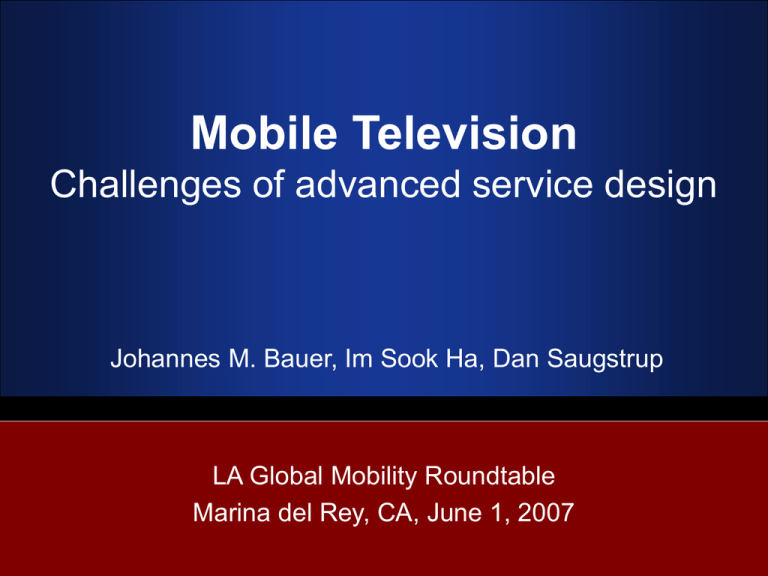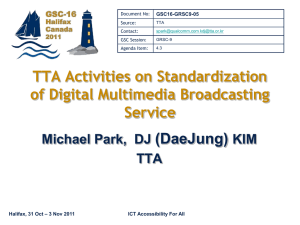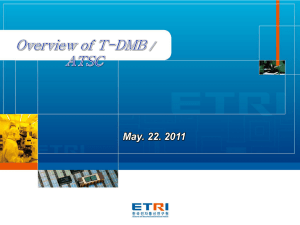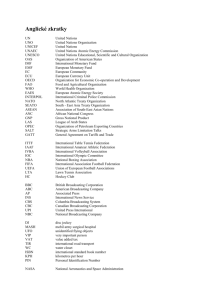Mobile Television: Challenges of advanced service
advertisement

Mobile Television Challenges of advanced service design Johannes M. Bauer, Im Sook Ha, Dan Saugstrup LA Global Mobility Roundtable Marina del Rey, CA, June 1, 2007 Overview Value net of mobile TV Platforms and solutions Factors shaping market evolution DMB in South Korea Lessons and outlook Value net of mobile TV Value-chain of mobile voice services Few players (equipment manufacturers, network operators, service providers) Standardization sufficient to coordinate Value-net of mobile TV services Larger number of players • • • • • • • Mobile operators Content providers Service providers Application providers Broadcast companies Network operators (mobile and broadcast) Equipment manufactures Challenges of coordination and service integration Platforms and solutions Platform/Solution Inband Digital Video Broadcasting Handheld (DVB-H) Unicast, existing handsets usable, opportunity costs of bandwidth Multimedia Broadcast Multicast Services (MBMS) Multicast, existing handsets usable, higher efficiency of bandwidth use Either Sling Media Terrestrial Digital Media Broadcasting (T-DMB) Outofband Features Satellite Digital Media Broadcasting (S-DMB) Media Forward Link Only (MediaFLO) User-driven and user-configured solution, 2.5G, 3G, WiFi Additional broadcast frequency needed (T-DMB: 170-230 MHz, 470862 MHz, 1.452-1.492 GHz); new handsets; investment in broadcast infrastructure; increased coordination needs between players Status of deployment Platform/Solution Deployment DVB-H Italy (3 Italia, TIM, Mediaset, Vodafone, all 2006), Finland (Digita/Nokia, 2006), U.S. (Modeo, HiWire Mobile TV, planned for 2007), Germany (planned for 2008), Spain, France (planned) MBMS Not yet commercially deployed Inband Either Sling Media Outofband 10 countries, including U.S., Canada, Brazil T-BMB South Korea (six providers, 2005, limited coverage), Germany (Mobiles Fernsehen Deutschland, 2006) S-DMB South Korea (TU Media, 2005) MediaFLO U.S. (Verizon, 2007) Factors shaping market evolution Technology Policy Spectral efficiency Propagation Bandwidth Spectrum policy Market design Industrial policy Mobile sector Performance/ evolution Economics Cost/risk/profit Supplier strategy Demand Sociocultural framework South Korean DMB infrastructure The satellite ‘HanByul’ Gap filler S-band DMB Broadcasting Station S-DMB T-DMB VHF Ch7~Ch13 (174~216MHz) Transmission tower Technology issues of mobile TV Frequency Standardization Equipment S-DMB T-DMB Ku band (12-13GHz) , S-band (2.630-2.655) - As power output is not limited by international regulations, the S-band is well-suited for broadcasting to small handset antennas VHF band III , L-band (1-2GHz) - Multiplexed T-DMB uses only 1.5-1.7 MHz making it easier to accommodate than the 6-8MHz needed by DVB-H System E - Uses CDM, similar to the CDMA technology ( Korea : competitive advantage) System A (Eureka 147 standard) -Backward compatible -Allowing use of the DAB (Stable and Mature technology) Gap filler - To cover areas not reached by the S-DMB or T-DMB signals, a gap filler system of repeaters is used. When making technology adoption, policy makers considered business as well as technology Influencing criteria such as the cost effectiveness of the infrastructure, equipment, and standards Closely linked to and co-evolved with technology and firm strategies Policy toward mobile TV (1) Licensing Policy Korean Broadcasting Commission KBC adopted RFP (Request for Proposal) for provider selection For T-DMB in Korea, there are three T-DMB service providers (KBS, MBC, SBS) and three nonterrestrial service providers (CBS, YTN DMB, KMMB) TU Media took a license as the first S-DMB service provider (in Dec. 2004) Before licensing, TU Media had already invested substantial capital in launching a satellite ($97 million), the installation of gap fillers ($230 million) and the establishment if a DMB broadcasting center($ 60million) The circumstances of policy in which government should support to DMB service were created Korean DMB was developed by a leading mobile provider’s technology-push to market rather than by market-pull T-DMB Date S-DMB Description Date Description Jan 2005 Call for service provider application Mar 2004 Launching of the satellite for S-DMB service Feb 2005 End of application acceptance period Nov 2004 Call service provider application Mar 2005 Service provider selected (6 providers) Dec 2004 Service provider selected (1 provider) Dec 2005 Commercial service May 2005 Commercial service Source : MIC Policy toward mobile TV (2) Retransmission of terrestrial TV programs via S-DMB S-DMB provider has insisted on retransmission (consumer needs, fair competition with T-DMB, …) KBC left the issue to contractual agreements between providers Terrestrial TV broadcasters have not signed retransmission contracts Pay service to T-DMB At least initially, advertising revenues would be too fragile and volatile to cover the costs of gap fillers and other start-up expenses Users wanted to maintain T-DMB as a free service, also VHF channels are regarded as a public asset Up until now, KBC has had difficulties in finding solutions to the T-DMB cost problem The profit structure of the industry could be changed according to how policies for competition are designed Business aspects of mobile TV Business issues Business aspects Supply Demand (Consumer perspective) Cost structure S-DMB T-DMB $500-800 million $ 50-80 million As T-DMB will mainly have to invest in a gap filler infrastructure, its costs are lower Rate $13/month Free Channels A higher number of channels A lower number of channels Coverage Nationwide Regional coverage Nationwide ( 08, 2007) Technology development Public Policy regime Competition in business environment will change due to future technology development and public policy regime T-DMB: pricing policy (Free rate Monthly flat fee, per channel fees, or charges for specific contents) S-DMB: Public policy (Contents Allowing retransmission of terrestrial TV programs) The Korean experience In addition to high initial cost, market demand has fallen short of expectations At the end of 2006, S-DMB reached an estimated one million subscribers. But due to initial investment cost and high fixed cost still loss-making Below 50% of short-term break-even goals of 2.2 million subscribers Optimistic predictions 6.6 million S-DMB subscribers by 2010 (TU Media) 10 million T-DMB subscribers by 2010 (ETRI) However, there are many issues awaiting solution Policy issues and conflicts waiting to be addressed by government Pay service for T-DMB Retransmission for S-DMB These issues will be repeated when Korea introduces other convergence services, already visible in IPTV and Wibro Solutions to these issues could lead to major changes to DMB business environment in the future Lessons and outlook Important technical and economic differences between platforms/solutions Factors shaping market evolution Frequency allocations (in-band, out-of-band) Eligibility for a mobile TV license Rules governing competition among providers Revenue model (pay, ad-financed, hybrids) Ability of providers to bundle with other services Competition by substitute services (e.g. vodcasting) Policy and market rules should eliminate bottlenecks and facilitate experimentation



